DriveSure
Now's the Time for New-Car Dealers to Focus on Used Vehicles
 While new-vehicle sales have rebounded nicely following the pandemic-related depths of 2020, current production delays and overall inventory issues threaten growth within the new-car market.
While new-vehicle sales have rebounded nicely following the pandemic-related depths of 2020, current production delays and overall inventory issues threaten growth within the new-car market.
“There are nearly 1.1 million fewer vehicles in inventory at dealerships this April (2021) versus last April (2020), and this tight supply situation will constrain sales,” notes Cox Automotive.

In particular, a global shortage of semiconductor chips has been slowing down manufacturing, along with other supply constraints.
“In the first quarter of 2021, production was also impacted by a reduced supply of resins used in many automotive parts, as well as by severe winter storms that caused manufacturing closures. The chip shortage is extending into the second quarter and will cause further vehicle production losses,” notes the National Automobile Dealers Association (NADA).”
That can leave new-car dealerships in a bind. Even if demand is strong, you don’t want potential customers waiting around until you have enough inventory to meet their needs. You want to close sales now. The solution, then, is to turn to another supply source: used cars.
Doing so can help maintain sales now while also building a pipeline of future customers who can return for servicing and to buy new cars down the road. And while dealerships face significant competition in the used-car market from the likes of CarMax and Carvana, let alone local used-car lots, new-car dealerships can stand out with their customer service, expertise, and unique incentives like DriveSure.
Benefits of Focusing on Used Cars
Even when the current chip shortage fades away, new-car dealerships can still benefit from building out a robust used-car business. Doing so helps dealerships:
Manage the risk of future inventory issues
Increase profit, as gross margins tend to be higher on the sale of used rather than new cars
Capture revenue for parts and service in the short term
Gain recurring customers in the long term
Not only can used-car sales increase revenue from car buyers, but simply getting vehicles in shape to sell can lead to more money for your service department. Keeping the work in-house effectively means that your used-car department becomes a customer of the service department.
This type of cross-functional work is key to maximizing gross profit. Your used car, new car, and service teams can work together to value trade-ins correctly, know what to send to the auction, what to buy at the auction, and figure out the ideal inventory mix to keep your customers happy.
How to Compete Within The Used-Car Market
While the benefits of selling more used cars are clear, some new-car dealerships may think they can’t compete with all the other players in the used-car market. However, new-car dealerships have several advantages.
For one, new-car dealerships can rely on their brand expertise, in contrast to generalist used-car businesses. Plus, new-car dealerships tend to have a lot more at stake than a place that only sells used cars.
For those used-only lots, once they sell a car, that can be the end of their relationship with that customer. But for your dealership, you can keep bringing them back for parts and service.
In other words, you need a strong reputation to not only sell used cars initially but to keep customers coming back. The more success you have in building up your reputation, the easier it can be to stand out from the competition.
One way to gain a strong reputation is to make the transaction process as friction-free as possible. If customers prefer purchasing online, for example, that’s well within the capabilities of most dealerships. Or, if customers are disappointed about a lack of new-car inventory, be ready to suggest used options that can still excite them.
Plus, new-car dealerships have a secret weapon — DriveSure. Only new-car dealerships can offer our service, which provides your customers with renewable road hazard tire protection, dealer-loyal roadside assistance, and emergency rental coverage with qualifying vehicle purchases and maintenance services. That provides a huge incentive to purchase a used car from you rather than getting a similar model elsewhere.
How to Get Used Car Buyers to Return for Service
After the sale ends, the work doesn’t stop. You want customers to return for service to gain more revenue, but this can also help strengthen your reputation if you continue to provide a smooth experience.
However, getting car buyers, especially those who purchase used cars, to return for service can be difficult. This is especially true if the vehicle is out of warranty.
That’s why dealers need to demonstrate the value of their service department to customers. Offering DriveSure can help, especially with used-car buyers, who otherwise may be unlikely to return for their first service.
The initial benefits of DriveSure might move the needle enough to persuade customers to drive the car off the lot, and then the fact that they can renew these protections just by coming in for their first routine service helps your dealership stand out from quick lube locations and other aftermarket shops. Plus, if customers have issues such as tire damage, they have an incentive to return to your dealership for repair or replacement.
Getting used-car buyers to come in for this first service is huge. Nearly three-quarters of car buyers who used their dealership of purchase for service say they’re likely to return to that dealer for their next vehicle purchase, finds Cox Automotive.

Be Ready to Serve Your Customers
The challenges of 2020 may have been highly unusual and unfortunate, but as the chip shortages in 2021 show, there can always be new issues that come up and affect your business in new ways. That’s why it’s important for dealerships to remain flexible and have multiple revenue streams in place so that you can continue to serve your customers however they prefer at that moment.
DriveSure
Why Dealerships’ Service Experience Starts With the Sale
You won’t get a second chance to make a good first impression
The relationship between a customer and a dealership’s service department doesn’t begin when the vehicle needs its first oil change. It actually starts as soon as the new vehicle owner agrees to sign on the dotted line.
Many customers only visit the dealership once or twice when they purchase a vehicle — making it difficult for dealerships to develop brand loyalty in the sales process alone. The service center is often where that loyalty is earned, so it’s crucial that your dealership’s sales team sets your service department up to delight your customers again and again.
Customers begin judging their experience as soon as they walk inside
From the moment they’re greeted by the sales team, buyers are evaluating how they’re being treated and whether they feel taken advantage of or if they’re getting a good deal. After all, most consumers have already done some research online, and they know that competition is high in the automotive industry.
If they aren’t happy at any point in the purchasing journey, or if they feel their needs are not being met, they’ll leave. That’s why providing excellent customer service and building trust will help dealerships stand apart from competitors — and it’s an important first step in getting customers to return for service.
You can earn that trust by sharing information like product reviews, buyer’s guides or case studies — resources that help them make informed purchasing decisions.
The sales-to-service handoff is a pivotal moment
Service revenue can have a significant impact on your dealership’s bottom line: NADA reports that while parts and service only made up 12% of dealership revenue in 2020, it can often contribute a substantially higher amount of gross profit than any other departments in a dealership. And as you know, the service department is also critical to retention and repeat sales.
And yet, a recent DealerRater poll found that only 42 percent of the 16,000 car buyers surveyed had been introduced to the service department upon making their purchase. Worse, 25 percent couldn’t remember whether they’d met any service employees.
Aligning the sales and service teams by introducing customers to the service department during the vehicle purchase makes them 1.5 times more likely to return for service and then again to purchase another vehicle, according to a recent Cox Automotive Maintenance and Repair Study. Dealers can improve that figure by making sure the sales-to-service handoff is a positive experience, beginning with a short tour.
A seamless sales-to-service handoff leaves customers feeling more confident – not only about their purchase, but in knowing where to turn when they have questions or need help with their vehicle moving forward. This way, the tone is set for the entire service relationship.
Get it right, and the car owner feels comfortable about trusting the service team down the line. Take up too much of their time, or waste it by not providing value, and the excitement over their new purchase fizzles out quickly.
Use this introduction and tour to begin educating customers about the maintenance schedule for their new purchase, and on the importance of returning on time for service to prolong the vehicle’s life and safety. Explain the advantage of having manufacturer-specific trained technicians onsite. And add more value by scheduling their first maintenance visit when you hand over the car keys, providing information about which repairs the service department offers.
Help customers understand what’s covered in their warranty
Nothing gets a vehicle owner more aggravated than showing up at the dealership’s service department expecting a repair to be covered and then finding out it’s not. That’s why it’s vital to make sure customers understand their coverage when they purchase the car. One way to do this is to walk around the vehicle itself, pointing out what is and is not protected.
Don’t offer an extended warranty as they’re leaving the parking lot. Instead, make this conversation part of the sales process, so clients can absorb what options are available. They’ll feel looked after knowing that every step of their ownership experience is covered.
Offer service-related incentives up front to bring customers back
Remember that great Honda service commercial from 2015 that warned vehicle owners, “Don’t open your hood to strangers”? Customers want to come ‘home’, but sometimes, they need a gentle nudge.
To motivate car owners to come back to your dealership for service, consider making it worth their while. Manufacturer-paid maintenance programs are one effective way to get them to come back. But not all dealerships have this option, and for those that do, the manufacturer doesn’t pay for maintenance forever.
That’s where an incentive program like DriveSure comes in — providing renewable roadside assistance, road hazard tire protection, and rental coverage at no cost to the customer for the length of the recommended service interval. Renewing the perks is simple: the customer just has to come back to the dealership for service or repairs. That means you get one more tool to delight customers every time they return.
Encouraging customers to bring their vehicles ‘home’ for maintenance and repairs starts the day they buy the car and before they pull away from your dealership for the first time, so don’t blow this important touchpoint.
Bill Springer has been helping dealerships grow their business at Krex, Inc. since 1987. As President of the organization, he is dedicated to helping service and sales departments provide unbeatable value to their customers. Krex’s signature solution, DriveSure, is specifically designed to make dealerships the only provider car owners depend on for maintenance, tires, and repairs.
No Comments
DriveSure
Why Dealership GMs Should Pay More Attention to Service
From hiring and training department heads to monitoring the daily operating control (DOC) to annual forecasting, resolving elevated customer complaints, and so much more —dealership general managers (GMs) have a bevy of responsibilities.
managers (GMs) have a bevy of responsibilities.
And while the most successful GMs have a well-rounded and diverse set of skills, many of them share a common element: they’re personable salespeople at heart.
Make no mistake — that experience is invaluable when it comes to motivating the sales team and helping to close deals on the lot and showroom floor. But by leaning too heavily on their sales background, some GMs neglect (or at least overlook) the importance of their dealership service departments, even if unintentionally.
When GMs place too much attention on vehicle sales, it’s inevitable that the parts and service department takes a backseat to dealership operations.
In this article, we’ll tell you why it’s important to strike a balance between sales and service, and share some tips to help you lead a more well-rounded dealership.
Are You Maximizing Your Fixed Ops Profits?
The parts and service departments play a big role in driving the success of dealerships.
According to the National Automotive Dealers Association (NADA), fixed ops accounts for an annual average of 12 percent of a dealership’s revenue, 60 percent of a dealership’s net profits, and approximately half of the gross profits. When you look at how profitable each department is on its own – those numbers make a lot of sense.

Clearly, dealerships' financial success depends on parts and service departments to deliver results.
Service, Parts, Sales: It’s All Connected
Fixed operations can help cover dealership costs, making the process of selling cars easier.
Your service department is important to not only ratcheting up fixed ops profits, but also generating future new car sales. Instead of a singular focus on vehicle sales, give your fixed ops department the attention it needs to be successful — by making sure everyone is on the same page to cross-sell services.

The first major step is making sure your salespeople are doing everything they can to get a buyer to return to the dealership for their first service visit. We dive into the sales-to-service handoff in this article, but key components include training your sales staff and making adjustments to your sales commissions program. Both of these require support and direction from the GM level.
Parts and service departments must also be in constant communication, and GMs can help ensure a successful relationship between the two. Carefully work together to regularly review stocking levels on parts. The longer a customer has to wait for a repair, or if common parts need to be ordered leading to longer resolution times, the more frustrated they become.
According to a recent DriveSure report, tires are another area that represent a substantial growth opportunity for dealerships. Less than a third of survey respondents reported purchasing a set of tires from their dealership. Even among customers who identified as extremely loyal to their servicing dealership, only half of them buy tires there.
This is a clear indicator that many dealerships are leaving money on the table. Not only are they losing tire sales to a competitor, they’re losing an opportunity to upsell or cross-sell and may be missing out on repeat business altogether.
If you’re not keeping a keen eye on how your parts and service departments collaborate — maintaining a well-trained staff and in-demand parts fully stocked — you run the risk of losing a customer’s business for good.
This may sound simple, but these are the things typically overlooked by GMs who aren’t as invested as they should be in the fixed ops side of the business.
Adopt a “Service Sales” Department Mindset
Sometimes it just takes a change in how you view your service department. Far more than just parts and service, consider them your “service sales department.”
Instead of looking at fixed ops as a cost-center where expenses should be cut, treat them like a sales department. In doing so, you’ll be far more likely to use your sales experience to employ the leadership tactics that transform fixed ops into the profit-generating machine it should be.
This can be done with a regular sales meeting with your service advisors and managers to review performance standards, revenue goals, forecasting, and customer retention.
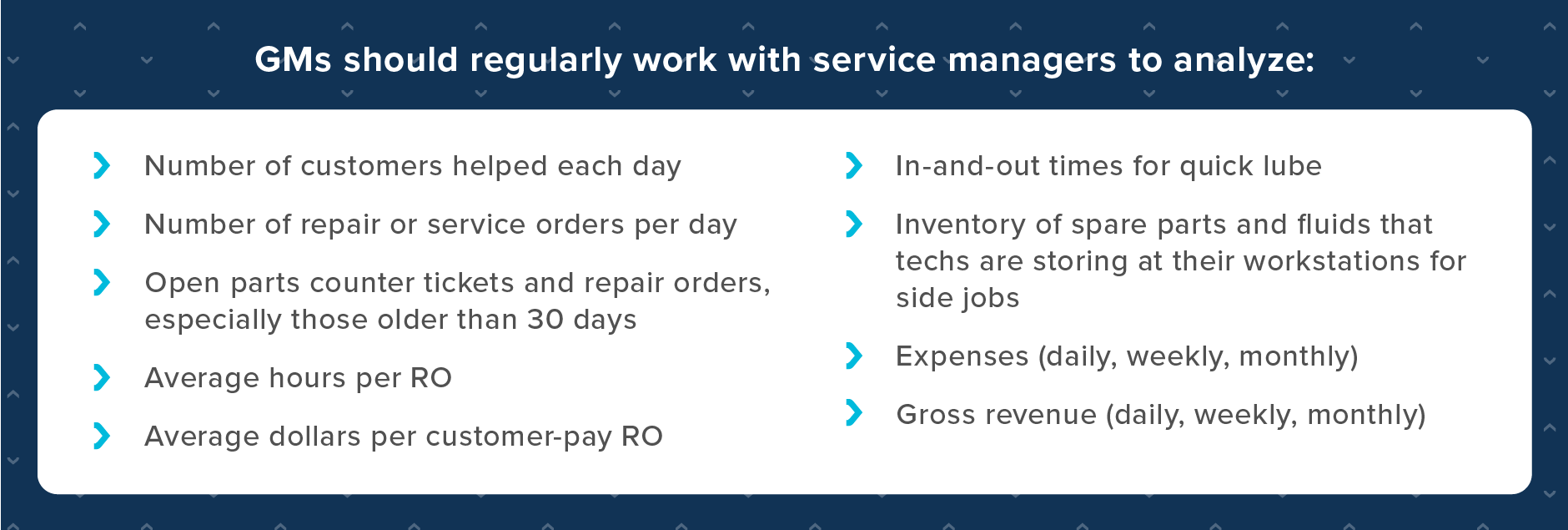
- Number of customers helped each day
- Number of repair or service orders per day
- Open parts counter tickets and repair orders, especially those older than 30 days
- Average hours per RO
- Average dollars per customer-pay RO
- In-and-out times for quick lube
- Inventory of spare parts and fluids techs are storing at their workstations for side jobs
- Expenses (daily, weekly, monthly)
- Gross revenue (daily, weekly, monthly).
This regular and open communication will show you’re invested in your team and allow you to better lead from a position of knowledge and trust. It also helps you immediately identify opportunities and address issues. And perhaps most importantly, it fosters a sense of camaraderie and empowerment among your fixed ops employees.
The Most Important Fixed Ops Metric
Once you’ve made the intentional decision to focus on fixed ops — generating greater collaboration between departments and adopting a service sales mindset — you’ll find that there’s one key metric driving profitability across the entire dealership: retention.
Getting vehicle buyers to come back for service means more parts and service revenue. Keeping service customers as their vehicles age results in larger and more frequent repair orders. Consistently delighting service customers gets them to come back to you for their next vehicle purchase. It’s all about retention.
There are many ways to help you retain more customers. Using DriveSure is one method with clear results. By providing customers with a unique set of benefits with every oil change and vehicle sale, DriveSure helps you keep customers coming back for service, tires, and unplanned repairs — all without complicated loyalty programs or profit-cutting discounts.
Bill Springer has been helping dealerships grow their business at Krex, Inc. since 1987. As President of the organization, he is dedicated to helping service and sales departments provide unbeatable value to their customers. Krex’s signature solution, DriveSure, is specifically designed to make dealerships the only provider car owners depend on for maintenance, tires, and repairs.
No Comments
DriveSure
5 Fresh Marketing Ideas to Rev Up Your Fixed Ops
Are you struggling to fill your service bays with new customers or retain existing customers? Or maybe you’re looking for big growth this year? Then it’s probably time to take a look at your fixed ops marketing strategy. The past 12 months haven’t been easy on many industries. Dealership service departments have had to adjust to meet evolving customer demands that have shaped the “new normal” for fixed ops.
marketing strategy. The past 12 months haven’t been easy on many industries. Dealership service departments have had to adjust to meet evolving customer demands that have shaped the “new normal” for fixed ops.
The struggle to stand out with impactful marketing is real. But last year’s DriveSure Dealership Retention Report did reveal some of the most effective fixed ops marketing tactics, according to your customers. For example, we learned that text messaging was quickly rising in popularity, regardless of age or generation.
In this article, we want to go a little deeper. Granted, not all service departments will have the capacity to take on all of these marketing tactics. The key is to develop a roadmap and start small. Begin with things you can execute and implement immediately, and they’ll produce results faster than you might think.
Here’s a list of 5 marketing ideas to help you get new customers into your service center — and make sure you hang onto your current ones.
1. Improve your SEO
SEO stands for search engine optimization. In a nutshell, it means your dealership service center comes up when customers search by name, proximity, vehicle issue, or question.
Example:
By Name: “Aspen Auto Clinic”
By Proximity: Auto Shops Near Me
By Issue: Brake Repair Colorado Springs, CO
By Question: How often should I replace my brakes?
No matter how impressive your website is, it’s all for naught if customers can’t find you.
To help potential customers find you online instead or your competitors, SEO should always be top of mind with your fixed ops marketing.
The more localized you get, the better.
For example, if you’re a dealer service center in Cleveland, your marketing campaigns, landing pages, and videos should go beyond “best auto service centers.” Instead, target keywords and phrases like “best auto service centers in Cleveland” or “brake repair shops in Cleveland.”
Some tools for checking and improving your local SEO results include:
- Local SEO Checklist from Synup
- Google PageSpeed Insights
2. Educate customers with video marketing
There is perhaps no better way to personalize your service department than with video marketing. Create a YouTube channel, produce a video or two to feature on the “home” or “about” pages of your website, and use short videos in your email marketing
Customer testimonials, videos with your staff and service manager, service center tours, and expert Q&As are all great ways to warm up to customers and make you look more approachable.
Example:
Many consumers don’t know the difference between conventional, synthetic, and high-mileage oil changes. Educate them with video marketing to set yourself apart. You might even consider including a personalized manager’s offer or promo code to incentivize the first visit.
For other potential video topics, consider things like:
- - Signs of alternator failure
- What does it mean when the steering wheel shakes?
- Questions to ask before my first service department visit
- What will void a new car warranty?
If you can produce regular video that attracts, engages, and delights your customers, it will go a long way in improving your SEO, establishing yourself as a credible automotive expert, and building confidence and trust among your audience.
3. Get active on social media
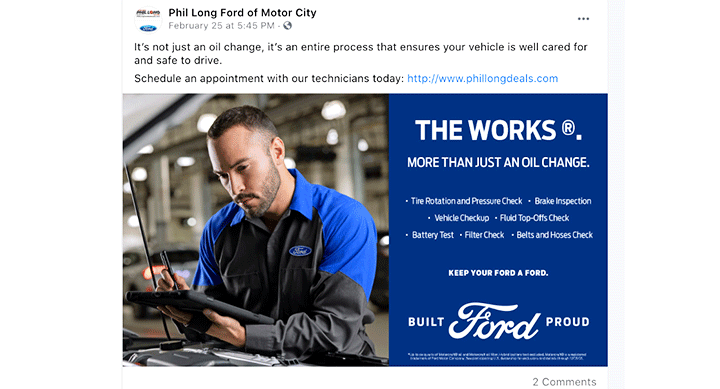
Simply take a scroll through Facebook on a Saturday afternoon. You’ll probably see people posting stories of vehicle issues and asking for recommendations.
Across Facebook, Twitter, and Instagram, social media can do more than just raise brand awareness for your fixed ops. It can show how you’re genuinely helping your customers. You may not become an overnight influencer, but here are a few best practices to optimize your engagement:
- - Retweeting and favoriting things your followers’ post
- Commenting on followers’ posts
- Being responsive to comments on your posts
- Responding to mentions
- Connecting with other professionals in your field or local area
- Uploading shareable videos, photos, and content
- Following/adding customers on social media
- Beyond just boosting your organic social media presence with the tips above, many dealerships choose to run paid social campaigns as well. With targeted ads (on Facebook, Twitter, and even Instagram) promoting your fixed ops and relevant specials, you can reach audiences that traditional media often overlooks.
4. Encourage customer reviews
Online reviews are great for helping potential customers decide on where to go for service. But they’re also essential for helping customers find you in the first place. When people in your community write about you online, it affects your SEO and increases your visibility (see #1).
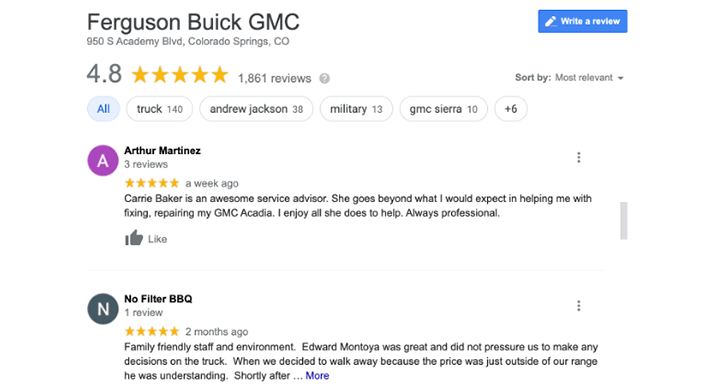
Like it or not, customers today are probably reading about you online before they pick up the phone or go online to make an appointment. So the more positive reviews you can bank, the better it is for your brand image. Here are some tips to help your service department get more positive reviews.
5. Launch a value-added incentive program
Incentive programs can be a marketing machine for dealer service departments. By partnering with the right provider, you can offer your current and future customers a unique suite of benefits with each oil change that both helps with retention and encourages future business.
Mazda of Orland Park is a great example of what incentives can do to supercharge fixed ops marketing. With an enticing program in place, they were able to increase their market share and improve customer retention resulting in 6X ROI.
Is Your Marketing Cutting Through the Clutter?
It can be difficult for fixed ops directors to ensure their service departments stand out in a crowded industry. But with the right strategy, you can make sure you’re front and center when customers are considering vehicle maintenance and repair.
Aside from unrivaled benefits that make you the go-to provider for maintenance, tires, and unplanned repairs, DriveSure’s experience with all things fixed ops marketing (including more tried and true tactics like SMS, email, and direct mail) can help you outshine the competition.
To find out how, contact us today for a free 30-minute consultation.
Bill Springer has been helping dealerships grow their business at Krex, Inc. since 1987. As President of the organization, he is dedicated to helping service and sales departments provide unbeatable value to their customers. Krex’s signature solution, DriveSure, is specifically designed to make dealerships the only provider car owners depend on for maintenance, tires, and repairs.
DriveSure
Tips and Strategies to Get More Positive Customer Reviews
Like it or not, customer reviews are a big deal for dealership service departments. We know, it doesn’t always feel fair that a seemingly innocuous set of “star ratings” can have such an impact. But it does.
But it does.
Many potential new customers are going online to vet you long before they make an appointment to bring their vehicle in for service. And what they read in that list of reviews will shape what they think about you before they drive into your service bay.
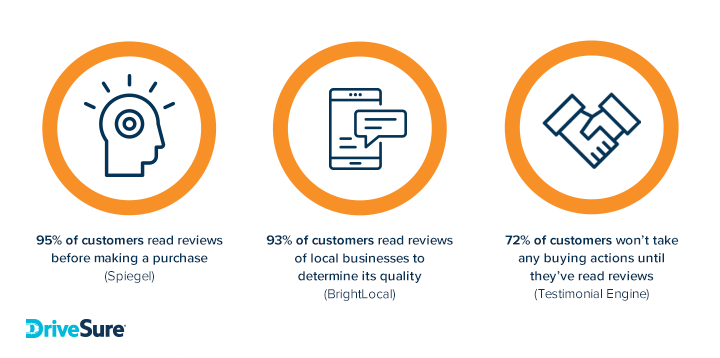
While those numbers may not be specific to auto dealership service departments, you can be sure they apply to our industry, too. Whether retaining current customers, getting new buyers to return for their first service appointment, or attracting new business — having a bank of (hopefully positive) online reviews is not only good for potential customers when they’re deciding on service and maintenance, it also helps them find you in the first place. When people in your community write about you online, it affects your SEO (search engine optimization) and increases your visibility.
Think of online reviews as a “navigational beacon” that can help point a potential customer in your direction!
Creating an Effective Customer Review Process
Getting customers to write reviews really is a virtuous cycle that can benefit your service department in many ways. But it’s not as easy as simply telling your team to ask customers to submit reviews. No amount of “review us” stickers in your lobby will singlehandedly have an impact on the number of reviews you generate.
Boosting the number and level of reviews comes from a well-defined process and some key habit-forming behaviors.
1. Provide Great Service
Great customer service is the catalyst for an exceptional customer experience. And a positive experience compels positive reviews.
Especially for dealer service departments who compete with local mechanics that often offer a lower price point for service. Providing superior quality of work and customer service will make it easier for you to elicit glowing reviews — and retain customers.
Every interaction counts. From the ease of using your website, to the way they’re greeted when they call, to their waiting room experience, post-appointment follow-ups, and so on.
Customers have even been known to review the cleanliness of the bathroom, type of on-site amenities, and the amount of paperwork they have to fill out. Some of that is out of your control, but spend time making sure that every touch point that is in your control is as personal as possible.
Ensure ease and convenience throughout the entire process, and your customer reviews will be a sight to behold — in both volume and rating!
2. Make it a Team Sport
One of the best ways to encourage and incentivize customer reviews is getting your entire team on board.
By simply telling the staff “Hey, we got four 5-star reviews last week, let’s see how many we can get next week.” Then, when you’re up six more reviews the following week, everyone high fives and feels great.
This is where a goal board or some visual back area of your office can serve as a reminder of the goal, and rally everyone’s efforts around boosting review numbers.
To accomplish this, it’s often as simple as making sure your techs and office staff stress how valuable customer feedback is during the check-out process and provide instruction on where to go online to leave a quick review.
3. Use Technology
We’ve talked before about why your dealership needs to truly embrace the digital age.
Tapping into digital marketing can be especially helpful in streamlining your customer reviews. Many dealership service departments use tools like Podium and RepLev to automate the process:
- - When the RO is closed, the system sends a text to the customer inviting them to share their feedback with a link
- - The link takes the customer to a page that asks then to leave a review on Google, Facebook, DealerRater, Edmunds, etc. (this can be customized
- - Automated email campaigns soliciting reviews can also be created as part of your customer follow-up
- - Many systems will even track and alert you to negative reviews so you can personally respond
All easy, non-invasive, one-click opportunities to gain reviews. And as your customers are becoming more open to being communicated to digitally, they’re happy to oblige and leave a quick review.

How to Leverage Positive Reviews
Having a sizable collection of customer reviews out in the Internet ether to help spread the word is great. But if you can creatively use some of those reviews to further promote your service department — that’s even better. Brad Deery Motors in Iowa does a great job leveraging their positive reviews for maximum traction and exposure.
Used in email campaigns, Facebook and Google Ads, and even on YouTube if you can get video testimonials, the “customer review ads” always receive a good response rate.
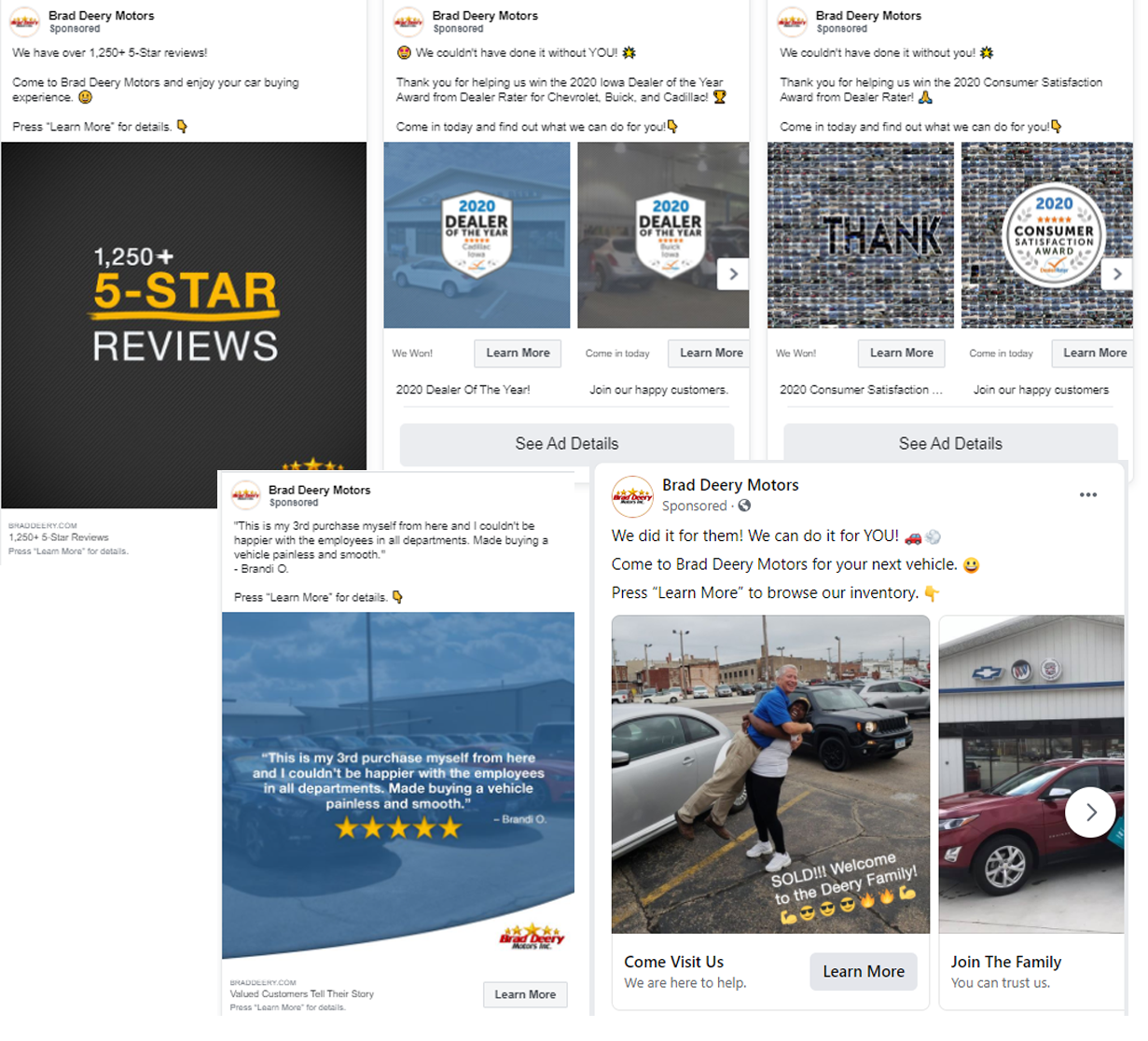
How to Handle Negative Reviews
Try as we might, we can’t please everyone. Negative reviews are inevitable, whether warranted or not.
So just be sure to regularly check your customer reviews on Google, Yelp, Edmunds, and DealerRater. It’s imperative you stay in the know on what they liked about their experience, what they didn’t like, and if they had expectations you couldn’t meet.
Acknowledge all reviews and personally respond to the negative ones with an effort to remedy the issue — get on the phone if you have to. Before you reach out, talk to any of your managers or employees who may have been mentioned in the reviews (good or bad) and understand their perspective.
Do You Have a Service Department Customers Can Rely On?
There’s no doubt customer reviews can help drive your business forward, and we hope some of the tips shared here will help increase your positive online reviews. Remember that ultimately, dealerships that offer unbeatable vehicle maintenance and customer service are far more likely to dominate the review’s arena, which in turn sparks interest in potential customers and future business.
If you’re interested in learning more about how DriveSure’s unique suite of benefits helps dealerships stand out from the crowd, contact us today for a free 30-minute consultation.
Bill Springer has been helping dealerships grow their business at Krex, Inc. since 1987. As President of the organization, he is dedicated to helping service and sales departments provide unbeatable value to their customers. Krex’s signature solution, DriveSure, is specifically designed to make dealerships the only provider car owners depend on for maintenance, tires, and repairs.
No Comments
DriveSure
How to Get Customers Back for Their First Service Appointment
The benefits of dealer-provided maintenance are undeniable. We know this, so why then can it often  feel like a herculean task to get customers to return to our dealership after their vehicle purchase?
feel like a herculean task to get customers to return to our dealership after their vehicle purchase?
If you could just get them back to the service lane one time — for their initial service appointment — you could prove your superiority, establish a service relationship, and make them a loyal lifetime customer.
Based on our experience, and the strategies proven effective by many fixed ops departments, here are a few tips to help you get customers back for their first service appointment.

Make it Part of the Delivery Process
A thoughtful and coordinated sales-to-service handoff is key, and can really improve your odds of getting customers to return for not just their first service appointment — but all subsequent maintenance and service needs. After the deal is inked, take advantage of the inevitable downtime while the vehicle is being prepped, detailed, etc., and give your customer a warm service department welcome.
Give them a service department tour. The last thing customers want is an uncoordinated and disjointed service and sales relationship. Your variable and fixed operations are a connected experience, and a great way to help ensure customers make the connection is to show them how all parts of your dealership coalesce into a single entity. A simple tour of the service department to see the techs in action will put them at ease and set the stage for personalized, quality care moving forward.

Show them how nice and clean it is. Introduce them to the service manager. Highlight the things that differentiate your service department from the competition. By creating a clear link between where they bought their vehicle and where they will service their vehicle, customers will be far more likely to see your service department as the obvious, if not only, choice to return for their first appointment.
Set their first service appointment. We know what you’re thinking. “No one knows their schedule a week from now, let alone in 6 months.” While true, it certainly doesn’t hurt to implement a best practice of helping your customer schedule their first follow-up appointment before they roll off the lot. It may be your last chance for a face-to-face before their first scheduled maintenance is due, and it’s simply more effective getting an affirmative response in person rather than counting on less personal follow-ups and reminders.
Don’t be pushy, and make it clear that it’s just a tentative placeholder depending on their driving habits. It’s rare that they won’t put something on the books before they leave if asked, and is an efficient way to make the customer more comfortable returning for service, increasing your chances of earning their business moving forward.
Deploy a Multi-Channel Marketing Campaign
Even if you get commitment on the first service visit as part of the purchase delivery process, every fixed ops director knows an appointment is a no show until they’re back in the service bay. So follow-up marketing and service reminders are critical in securing that first visit.
When done correctly, an omni-channel marketing campaign will keep your service department top of mind with new customers, and there are several tactical examples to prove it.

Through multiple touchpoints, remind your customers that they are due for service, and stress the benefits and value they’ll receive when they choose you over a local mechanic or mass merchandiser.
Start with a simple direct mail postcard that might include coupons applicable to their first service requirements. Then keep your service department atop their inbox with a series of emails (don’t overdo it, just a couple leading up to their first appointment). You may even consider mobile alerts and text messages if you have the capabilities. A recent DriveSure study showed that consumers are more than open to receiving texts from their dealership.
Use video to underscore your value
As part of your email marketing, consider including short videos from your service manager. This adds a personal touch, and can also stress all the points that make your service department better and more knowledgeable. Many consumers don’t know the difference between conventional, synthetic, and high-mileage oil changes — educate them with video marketing to set yourself apart. You might even consider including a personalized manager’s offer or promo code to incentivize the first visit.
Offer Incentives
Speaking of incentives, they can be another enticing way to book that first appointment. It can be costly to your bottom line to offer discounts for repeat service, and incentives are an easy way for your service department to add more value to the customer without relying on undercutting discounts.
For example, dealerships that offer DriveSure (our product) with new and used car sales have seen significant increases in the number of customers who return for that first service visit. DriveSure gives vehicle owners a suite of benefits at no extra cost to them, including dealer-loyal roadside assistance, road-hazard tire protection, and more, that are valid for a set period such as 180 days. To renew those benefits when they expire (or before), customers must return to the dealership for their scheduled maintenance – increasing the chances of their vehicle running smoothly and giving them peace of mind in case it doesn’t.
Other incentives you could offer include things like:
- VIP card they can use to get a 10% discount on accessories
- Loyalty programs
- Pickup and delivery service
- Free car wash with every oil change
To learn more about how your dealer service department can start off as (and remain) the go-to provider for maintenance and repairs, schedule a free consultation with a DriveSure expert today.
Bill Springer has been helping dealerships grow their business at Krex, Inc. since 1987. As President of the organization, he is dedicated to helping service and sales departments provide unbeatable value to their customers. Krex’s signature solution, DriveSure, is specifically designed to make dealerships the only provider car owners depend on for maintenance, tires, and repairs.
No Comments
DriveSure
10 Ways to Build Customer Loyalty from Fixed Ops
It’s long been said that acquiring a new customer costs 5 times as much as retaining a current  customer.
customer.
So then why do so many companies spend the majority of their time, energy, and budgets looking for new business, when they could be more focused on preserving the customers they already have? According to a recent study by Invesp:
- • 89% of businesses see customer experience as a key factor in driving customer loyalty and retention.
- • 76% of companies see Customer Lifetime Value as an important concept for their organization.
• The success rate of selling to a customer you already have is 60-70%, while the success rate of selling to a new customer is 5-20%.
- • Increasing customer retention rates by 5% increases profits by 25-95%.
Those numbers are pretty telling, and certainly applicable for dealer service departments — whose revenue goals hinge on engaging, delighting, and retaining their vehicle owners.
To both maximize fixed ops profits and generate new car sales, getting customers to return to your dealership for service is critical to your success. Here are 10 of the most compelling automotive customer loyalty strategies fixed ops and service directors use to increase retention.
1. Provide quality work and great customer service.
Let’s start with the most obvious. Fixed ops departments pride themselves on the quality of their work and service, and despite threats from low-cost competitors, superior work is what really builds trust and keep loyal customers coming back. As for the customer experience, there are many services and amenities your customers expect these days. Make sure you’re meeting customer expectations every time they visit you for service — especially because even the most loyal of your customers say they’d consider going elsewhere after just one bad experience (according to DriveSure’s recent Dealership Service Retention Report).
2. Have a memorable sales to service handoff.
Nothing fosters customer loyalty quite like making them feel comfortable. A quick and easy way to do that? A simple introduction by your sales rep to the service team after a vehicle purchase. You’ll put them at ease and set the stage for quality care and personalized service from the outset.
3. Get involved with your community.
Car dealerships are community organizations…so get out in the community and make your presence known! Partnering with charities and local groups to help them through car wash fundraisers and pairing your referral program with local organizations are just a couple of ways to stay top-of-mind. By getting your name out there and providing value, you’re more likely to become the go-to place for the community for everything from oil changes to tire rotations.
4. Rewards and contests through social media.
We’ve seen some dealer service departments find success by engaging their customers through social media. If you have a Facebook or Twitter account, put out a post encouraging your followers to “guess the score of the big game,” and offer a $50 reward card to whoever wins (first to comment with correct score, or first that comes closest). Getting creative on social media is a great way to increase your awareness and stay top of mind with customers — you can even consider reloading the gift card to incentive referrals in the next 24 hours.
5. Take extra care of unsatisfied customers.
By simply keeping a close eye and staying on top of your customer reviews, you can show your current customers you’re always listening to them, actively trying to meet their needs with better service. When you see a negative review, reach out directly to the customer to discuss how you can fix their issue. Opening up a cordial dialogue, following up with a personal thank you card (and even small gift card for a cup of coffee) can go a really long way.
6. Customer appreciation initiatives.
Provide unique offers, events, and rewards to your more frequent customers. By offering discounts in your online dealer store, exclusive service specials, free vehicle detailing, or even special gift packages, it shows you’re willing to go above and beyond to “surprise and delight.”
7. Send birthday and holiday cards.
A little personalization can go a long way. In fact, 88% of marketers say personalized messaging can improve results. Sometimes it’s the little things that play a big part in retaining customers — like sending birthday cards and holiday greetings via email (50% of service department customers prefer email communication between visits, according to DriveSure’s Dealership Service Retention Report).
8. Partner with dealership benefits programs.
Some programs make it easy for new car dealerships to provide a unique suite of benefits with each routine maintenance visit. Not only do these benefits encourage customers to return the next time they need scheduled maintenance, they also establish the dealership’s service department as the go-to place for tires and unplanned repairs.
9. Offer your own maintenance packages.
By giving your car-buying customers the benefit of 12-months of complimentary maintenance, you immediately plant the seed of long-term loyalty. Then it’s up to you to nurture and grow the relationship with exceptional customer service and high-quality work (see #1) Don’t give your customers the option of immediately going elsewhere for service…and don’t force them to use you through fear of voiding their warranty. Getting off on the right foot is a great first step in customer retention, pardon the pun.
10. Loyalty incentives.
Pairing dealer loyalty incentives with your complimentary maintenance package can further foster long-term retention. Allowing customers to earn points for every dollar they spend on service will keep them intrigued and engaged to continue their service with you after their free package expires. With loyalty account activation, customers can begin accumulating points toward exclusive service discounts and even future vehicle purchases.
Create a Service Department Your Customers Can’t Resist
Interested in learning more about how you can make your dealership the only one your customers depend on for maintenance, tires, and repairs? We can help! Schedule a free 30-minute consultation today and we’ll show you exactly how DriveSure can improve customer loyalty for your dealership – and what that will mean for your bottom line.
Bill Springer has been helping dealerships grow their business at Krex, Inc. since 1987. As President of the organization, he is dedicated to helping service and sales departments provide unbeatable value to their customers. Krex’s signature solution, DriveSure, is specifically designed to make dealerships the only provider car owners depend on for maintenance, tires, and repairs.
1 Comment
Sex
Most sites don’t give their clients any control over writer selection options. We are focused on implementing a different approach, so when you choose to buy essay, you have options. First, we pick the best expert for you as other companies do it, though, we evaluate professional areas and your requirements meticulously unlike most of them. Second, for ensuring an even better fit, you may select them yourself. Their profiles are open and you are free to check them before settling on one. You can communicate with them directly to ensure that everything is understood and buy an essay only after that.
DriveSure
New Study: Even Loyal Customers Leave After a Bad Experience
What’s the easiest way to turn your dealership into an engine of profit?
Keep more customers coming back for service, more often.
Okay, maybe it’s not all that “easy,” but it is possible.
In fact, nearly 2,000 dealership service department customers have spoken, and what they had to say on the topic might surprise you. It’s all detailed in our 2020 Dealership Service Retention Report, and it’s loaded with valuable, actionable guidance to help make customer loyalty and retention not only a possibility, but your new reality.
Let’s take a look at some of the findings.
Why Would Customers Go Elsewhere For Service?
We’ll start with the big one. In what was perhaps the report's most eye-opening revelation, we found that a single bad experience at the dealership puts it at risk for losing any customer, regardless of their loyalty.
Those with no allegiance jumping ship, totally understandable. But when nearly half (49%) of those who self-identified as “extremely loyal” customers said that they’re likely to consider leaving if they have just one bad experience at the dealership, we did a double-take.
No do-overs...even from our most staunch supporters. Seems a bit harsh, but perhaps it’s just the wake-up call we need right now.
On a lighter note, we can take solace in the fact that a quarter (24%) of the extremely loyal group said “nothing” would make them consider going elsewhere.
Here’s the high-level view of what might cause customers to go somewhere else for service:
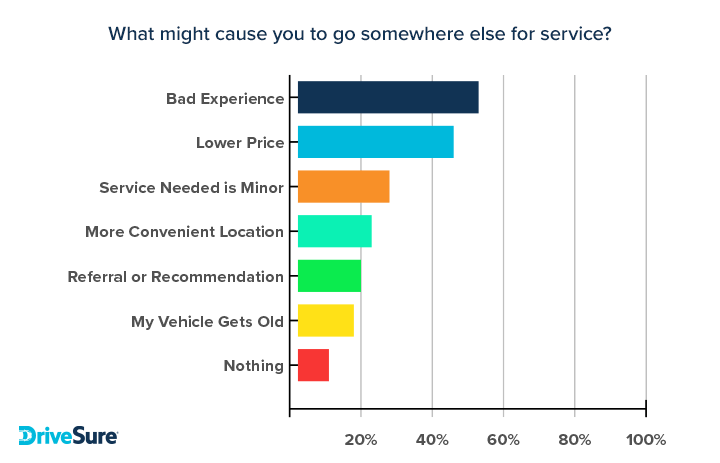
And now the full view, breaking the responses down by customer loyalty:
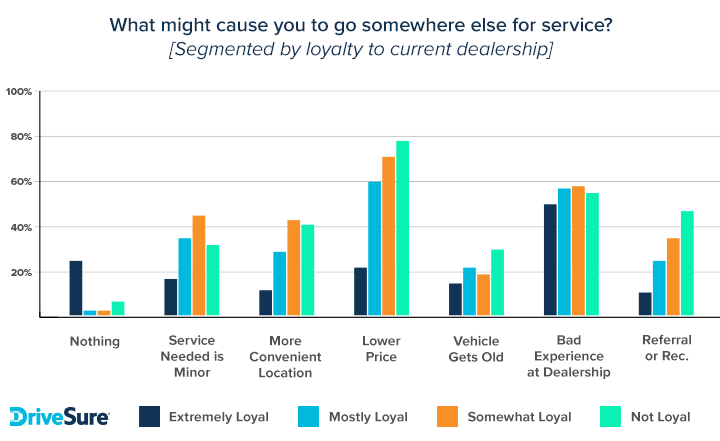
Leaving for a lower price was the most popular choice among everyone (excluding the “extremely loyal”) with 46% of the 2,000 participants saying price is a big factor. When you break the numbers down by age, and 56% of consumers under 34 told us they would consider leaving their dealer service department for the lowest bidder.
Our main takeaway here is this:
For dealerships that effectively delight customers and prove value, the findings indicate that the vast majority of respondents would keep coming back — if the customer experience remains consistent and superior.
The fact that over half (53%) of all those surveyed said just one bad experience could send them packing is indeed a daunting prognosis, but certainly not incurable. Now’s the time to make sure you’re doing everything possible to create a memorable experience that retains and increases service traffic by implementing proven tactics and best practices.
But Enough About Dealership Defection…
What are the factors that influence and encourage customers to come back to your dealership for service?
Some of the responses here might provide you with much-needed validation. Others might illuminate areas for improvement.
Customer Service is Big, Quality of Work is Bigger
When asked to rank several items by how important they are when determining where to go for vehicle service, “quality of work” was the clear winner. Second most important was “price,” with “quality of customer service” nipping at its heels.
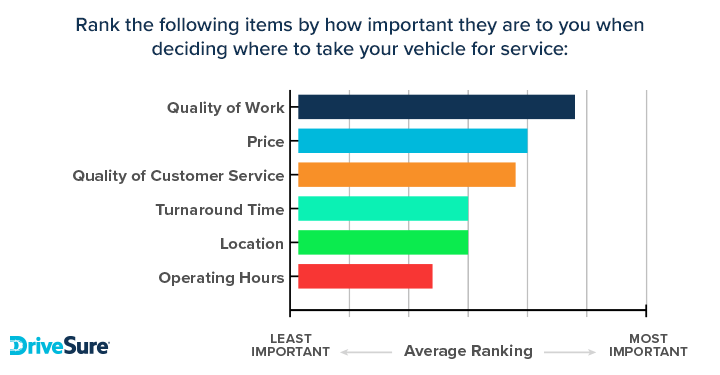
This is mostly good news for dealerships, many of which already pride themselves on the quality of their work and their service. However, it does highlight what service managers already know, low-cost competitors always pose a threat.
Overcoming the Price Factor
Sometimes, dollars and cents just make sense.
It’s a bottom line world, after all.
That said, there are ways dealership service departments can differentiate themselves and stand out from their competition, regardless of price points.
Focus on quality and make it known that the price your customers pay is well worth what they receive. You are the foremost experts and caregivers on their specific makes and models, no one else.
By emphasizing the competency of your technicians, ensuring your staff is delivering a delightful experience, and adding a valuable package of unique vehicle owner benefits that customers won’t find with cheaper competitors, many dealerships have no issue overcoming the price factor.
We found this is especially true for more senior customer segments, who don’t care as much about price as they do the quality of work and service.
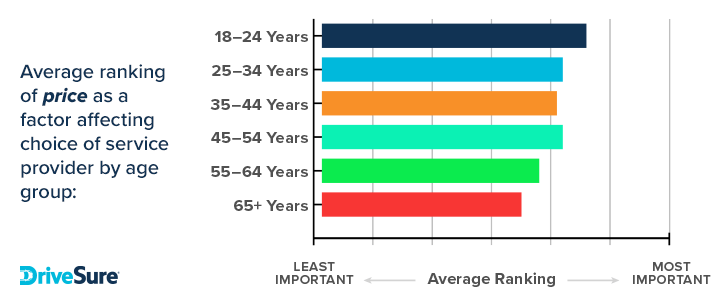
What Services Do Customers Want From a Dealership?
The significance of the 2020 Dealership Service Retention Report can’t be overstated. It’s the only one of its kind—conducting research exclusively from those already getting their vehicles serviced at a dealership.
That makes this next point even more impactful.
44 percent of respondents prefer to get all their vehicle service needs performed at a dealership.
As for the remaining 56 percent, it’s the type of work needed that factors heavily into their decision for where to take their vehicle. The top five services that those consumers prefer to get from a dealership are:
1. Manufacturer-recommended maintenance (77%)
2. Electrical issues (63%)
3. Unknown issues/check engine light warnings (63%)
4. Oil changes (63%)
5. Transmission work (57%)
The three services they’re least likely to prefer to have done at a dealership are:
1. Battery replacement (18%)
2. Body work (21%)
3. Tire rotation or repair (33%)
Since people are less likely to return with issues related to batteries, tires, and brakes, it underscores the importance for service advisors to identify those issues while the customer is already at the dealership. Not only can this prevent the customer from going elsewhere for those services, but it also gives dealerships an opportunity to avert future issues for their customers before they even occur.
We Now Return to Your Engine of Profit
Ultimately, consumers who both purchase and service their vehicles at a certain dealership are also likely to buy their next vehicles at that same dealership, thus bringing in a new sale and more profits from services.
With nearly half the consumers in our study already planning to purchase their next vehicle at the dealership where they service their current one (and 45% undecided), every future service visit is another opportunity for your dealership to wow your customers and earn their repeat business.
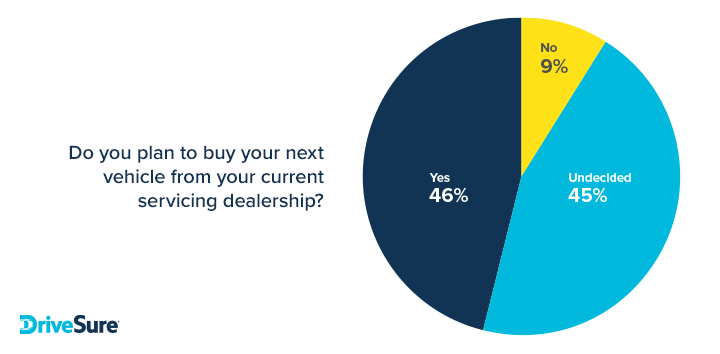
Now that you know what keeps them coming back for more, and perhaps most importantly, the things that drive them away, you’re poised to become the only one your customers depend on for maintenance, tires, and repairs.
To dive even deeper into the unique perspectives of your target customers and discover the secrets to dealership service department retention, get your full copy of the 2020 Dealership Service Retention Report here.
Bill Springer has been helping dealerships grow their business at Krex, Inc. since 1987. As President of the organization, he is dedicated to helping service and sales departments provide unbeatable value to their customers. Krex’s signature solution, DriveSure, is specifically designed to make dealerships the only provider car owners depend on for maintenance, tires, and repairs.
No Comments
DriveSure
Texting Is Now the Top Preference for Service Customers
 Texting has come a long way since the days of flip phones and message limits. What was once a communication channel reserved only for our closest friends and family is now a common way we interact with businesses.
Texting has come a long way since the days of flip phones and message limits. What was once a communication channel reserved only for our closest friends and family is now a common way we interact with businesses.
This evolution isn’t exactly new, but we were still a bit surprised by some of the stats that came out of our 2020 Dealership Service Retention Report. For the nearly 2,000 dealership service customers we surveyed, texting wasn’t just a popular communication method. It was consumers' favorite way to receive communications from a dealership – by a long shot.
Texting Preferred Over Calls by Nearly 3 to 1 During Service
When we asked our research participants to identify their most preferred way to hear from a dealership during a service visit, 60% of them identified text messages. A phone call was the second most common choice, but it was picked by only 22% of respondents, trailing texting by a significant margin. In fact, phone calls beat out email by just 7%.
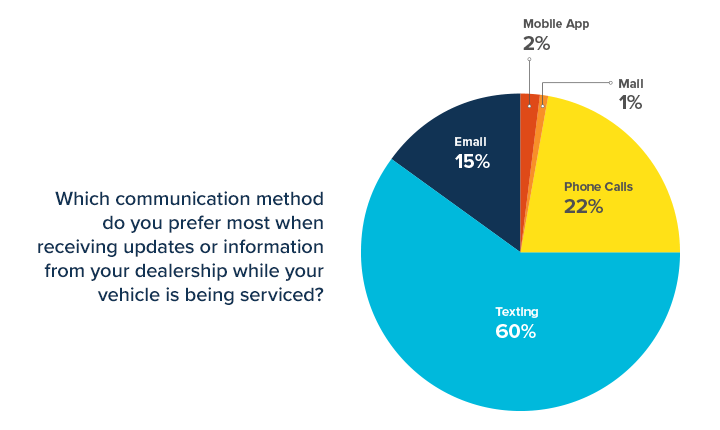
So if your dealership is still questioning whether customers are open to getting texts from you, wonder no more. Not only are they open to it, but the majority of them actually prefer it.
What about more senior customers? Yes, them too. Texting was the preferred communication method for every age group we surveyed. While the margin between texting and calls wasn’t as wide for customers 55 and above, they were still twice as likely to prefer a text over a call.
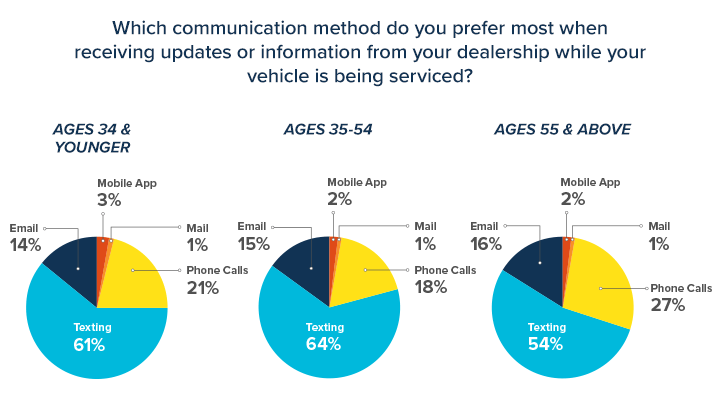
In addition to figuring out how customers wanted to be contacted while their vehicle was getting serviced, we also wanted to know what they preferred for the less immediate communications between visits. It turns out texting is pretty popular for that as well.
Texting Is Second Most Popular Preference Between Service Visits
Email has long been the king of non-urgent customer communications, and our research shows that texting hasn’t dethroned it yet. 50% of the service customers we surveyed prefer to receive emails over other communication methods between service visits.
However, texting does have a strong hold on second place. Nearly a third of the people we surveyed prefer texts (32%), followed by phone calls (12%), mail (4%), and a mobile app (2%).
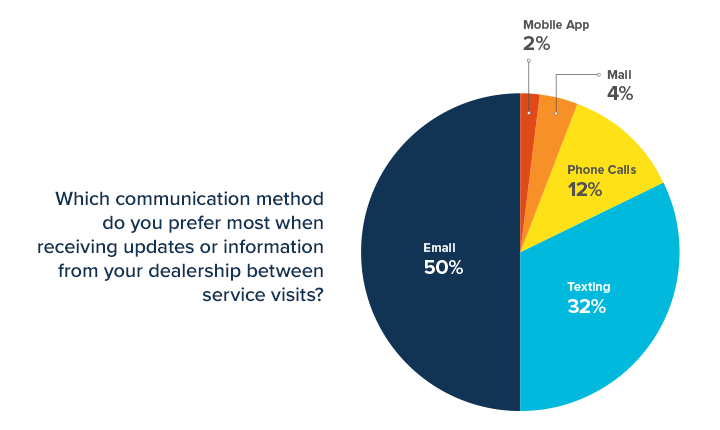
Again, the preferences stayed in the same order across age groups. About the same percentage of customers ages 34 and younger preferred texting as those 35-54 (37% and 36% respectively). For people 55 and above, they were slightly less likely to prefer texting (23%), with email making up the majority of the difference.
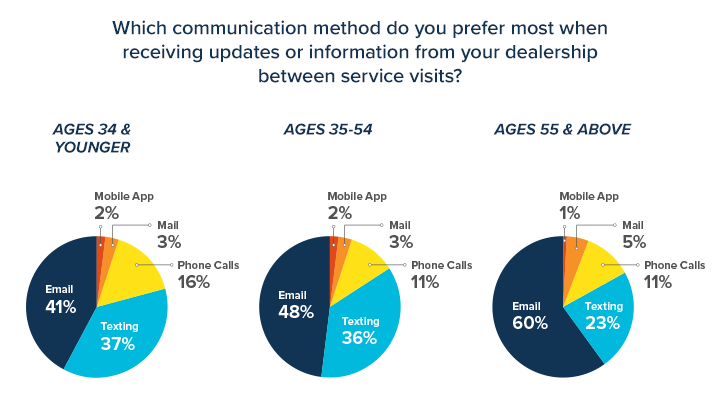
We see two big takeaways for dealerships here:
First, maintain your email strategy. It seems that questions come up every year about whether email is dead or dying – this data clearly shows that it’s still an effective tool.
Second, texting shouldn’t just be used for real-time communication while you’re servicing a customer’s vehicle. It can also be a great way to reach customers between service visits for things such as service reminders.
There’s one caveat to this data we want to mention. The question we asked was for participants to choose their most preferred communication method, and they were only able to pick one. So, while mail didn’t perform well as a top choice, we know from our work with dealerships that direct mail is still a valuable tool for driving business.
Dealerships May Not Be Keeping Up
So how are dealerships’ communication channels lining up with their customers’ preferences? It turns out that there is some alignment, but many dealerships still have some work to do.
Almost 90% of people surveyed get emails from their dealership. This shows that dealerships have a good handle on the most preferred format for messages between service visits.
However, more than 40% of people surveyed don’t get any texts from their dealerships. If the data about communication preferences is clear about one thing, it’s that the dealerships that haven’t adopted a solid strategy for sending text messages to customers should start now.
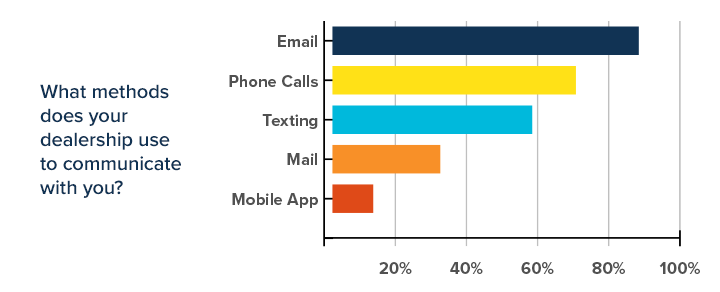
But when it comes to modernizing communications with customers, dealerships may not want to stop there.
What’s Next for Dealership Communication?
At DriveSure, we’re laser-focused on helping dealerships bring more customers back to their service department more often. In addition to our suite of renewable, value-added benefits like roadside assistance and tire coverage, we help dealerships send the most effective service-reminder messages possible.
Over the last year or so, we’ve introduced a new form of service reminders called our Digital Pass. Among other functions, it allows customers to get app-like notifications on their smartphone when it’s time to return to the dealership’s service department.
Since this is a brand new form of communication in the industry, we wanted to gauge dealership service customers’ reactions to it in this survey. To be honest, even we were surprised by what we found.
Over half of the participants told us they would be likely or very likely to download a digital reminder notice on their smartphone to receive service reminders. Based on this response, we’re confident that smartphone notifications through tools like the DriveSure Digital Pass will be the next evolution in modern communication with your customers.
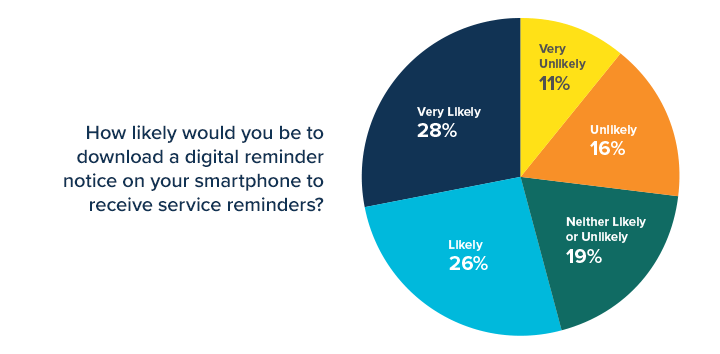
What Dealerships Should Do
Dealerships that aren’t yet texting customers during and between service visits, should begin looking into the technology that makes this easy. For those that already text customers, begin thinking about what’s next on the horizon for effective customer communications. If you need help implementing texting or smartphone notifications, or you just want to boost retention and service visit frequency, we’d be happy to chat.
Otherwise, be sure to grab a free copy of our 2020 Dealership Service Retention Report for more insights from nearly 2,000 dealership service customers about why they return for service, why they don’t, and what your dealership can do about it.
Bill Springer has been helping dealerships grow their business at Krex, Inc. since 1987. As President of the organization, he is dedicated to helping service and sales departments provide unbeatable value to their customers. Krex’s signature solution, DriveSure, is specifically designed to make dealerships the only provider car owners depend on for maintenance, tires, and repairs
3 Comments
DriveSure
Hi Morgan, great question! Our survey respondents were service customers at a wide variety of dealerships across the country. Different states, makes, and dealership sizes were represented in the results.
DriveSure
New Data: Even Loyal Service Customers Buy Tires Elsewhere
 It's widely known that dealerships still have a lot of ground to make up when it comes to selling tires. According to Modern Tire Dealer, auto dealerships still handle just under 10% of the total tire market as of 2019.
It's widely known that dealerships still have a lot of ground to make up when it comes to selling tires. According to Modern Tire Dealer, auto dealerships still handle just under 10% of the total tire market as of 2019.
But what about the customers that are already coming to you for vehicle maintenance? Surely they are buying tires from your dealership, right?
Well, yes and no.
According to our recently released 2020 Dealership Service Retention Report, auto dealership service customers do buy tires from their dealership. But not nearly as many as you might think.
How Many Dealership Service Customers Buy Tires at the Dealership?
In our survey of nearly 2,000 dealership service customers, only 31% purchased their last set of tires from the dealership. This means that less than a third of the customers coming to your dealership for service will come to you for tires too. Even for customers who stated that they were “extremely loyal” to their servicing dealership, less than half (48%) purchased their last set of tires there.
Why aren’t more of them buying tires from the dealership?
One answer may be that they don’t even know their dealership sells tires. Nearly a quarter (24%) of the people we surveyed selected “I’m not sure” when asked if their dealership sold tires. For those extremely loyal customers, that number fell only a few points to 20%.
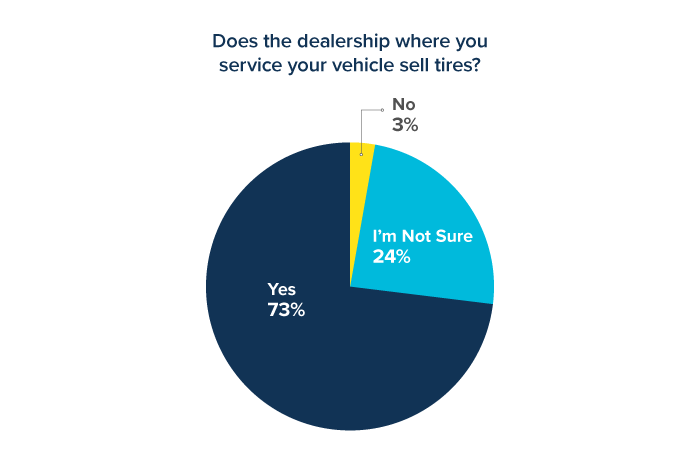
If 20% of a dealership’s most loyal service customers don’t even know if they can buy tires from the dealership, it’s no wonder why so many aren’t buying their tires there.
Where Are Dealership Service Customers Buying Tires?
You may be wondering, for customers who aren’t buying tires from the dealership, where are they going instead?
According to our survey, they’re overwhelmingly going to tire stores (59%). Big-box retailers such as Costco and Sam’s Club also enjoy a decent portion of the market at 20%.
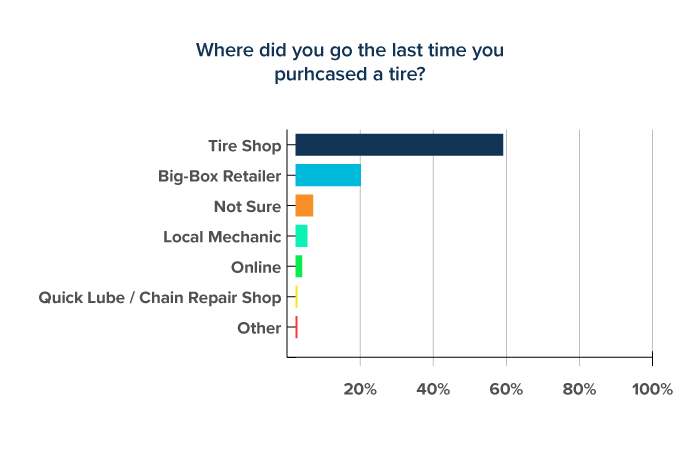
With such a large percentage of your existing customer base not buying from you, tires represent one of the most significant opportunities to grow your fixed operations. Let’s face it, you have much more to offer your customers than the competition.
The question is: What can you do to make sure your customers know this too?
Here’s what we think.
What Dealerships Can Do to Earn More Tire Business
Every time a customer takes their vehicle somewhere else for tires, you lose business. First, you lose the initial revenue from the tire sale. Second, you lose the opportunity to earn repeat or add-on business.
Don’t let them get away!
Talk About Tires and Tire Services More
If your customers don’t know you sell tires they won’t come to you when they need them. So, at the very minimum, we recommend you start talking about them more.
Here are a few ways to do that:
- 1. Tell your customers about your tire offerings and their warranty coverage at the sales-to-service handoff. This is a key action in building loyal customers. Because, as you know, getting a vehicle owner into your service department for their first service visit makes them more likely to continue coming to you for all their vehicle’s needs.
Download this checklist to learn about other best practices for this critical point in the car buying experience.
- 2. Remind your customers of the recommended service schedule for tires. With extended recommendations for oil change frequency, tire rotations may now be your best opportunity to see your customers more often.
- 3. Add them to a digital reminder campaign. We recommend sending emails, or text messages to your customers (a method that was verified to be preferred in our survey) to remind them to have their tires rotated. You could also add seasonal reminders like putting on snow tires once the temperature drops consistently below 45°F.
4. Setup a geofencing campaign that targets your nearest tire competitors. Using this approach to catch customers at the right place at the right time keeps your dealership top-of-mind when your customers’ buying intent is highest — for example, when they’re on the property of a competitor.
If you’re successful in getting your message out, you’ll begin to make your dealership the place your customers think of when they need tire services. But, if you really want to be successful, we recommend finding ways to truly differentiate your dealership from the competition with a reason to return.
Introduce Value-Added Services Focused on Tires
Programs like DriveSure, which offers a renewable set of benefits included with oil changes and scheduled maintenance services, help dealerships drive more tire business with perks including:
- Road hazard protection:
Free tire replacement or repair of damage due to road conditions or debris.
- Roadside assistance:
Complimentary tows to their dealership and not the competitors’.
When customers run into trouble, these kinds of programs make it convenient and easy to come back to their dealership for help.
This approach has worked incredibly well for the Parts and Service Director at Kastner Honda. He’s leveraged DriveSure to sell more tires at three separate dealerships: read his story.
____________________
If you’re serious about gaining traction in the tire market, customers have to think of you when they think of tires. Remind them of your tire offerings often and make it easy for them to come back when they’re in need.
For more customer insights and tips for getting customers to return to your dealership, download a copy of our full 2020 Dealership Service Retention Report here.
Bill Springer has been helping dealerships grow their business at Krex, Inc. since 1987. As President of the organization, he is dedicated to helping service and sales departments provide unbeatable value to their customers. Krex’s signature solution, DriveSure, is specifically designed to make dealerships the only provider car owners depend on for maintenance, tires, and repairs.
2 Comments
Phone Ninjas
Although working at a dealership, I've definitely purchased tires elsewhere.

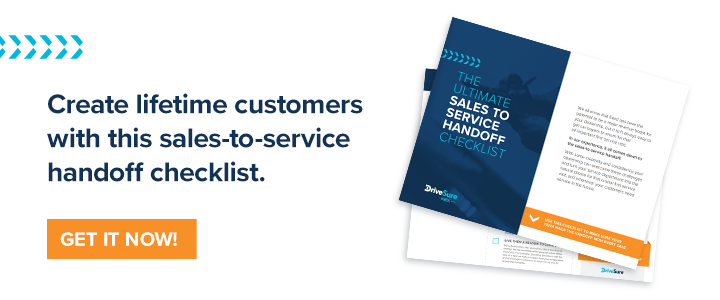
No Comments